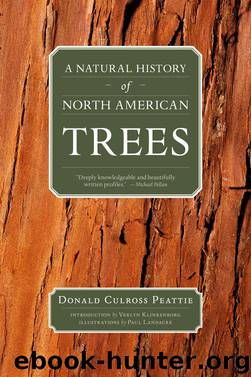A Natural History of North American Trees by Donald Culross Peattie

Author:Donald Culross Peattie [Peattie, Donald Culross]
Language: eng
Format: epub
Publisher: Trinity University Press
Published: 2013-04-24T23:00:00+00:00
And now, as the hungry and exhausted men toiled through the gigantic jackstraw timbers of Idaho’s primeval forests, the captains sighted, on September 20, “an Arbor-vitae” — one they noted as “very common and grows to a great size, being from two to six feet in diameter.” Next day their journal remarks that “the arbor vitae increases in size and quantity as we advance,” down toward the open valleys of the Clearwater. So on the twenty-fifth William Clark, with the Nez Percé chief Twisted Hair, set out to find a promising grove of this new great tree. Near the present town of Orofino, Idaho, he located his boat timber, and here the party felled the trees whose stumps were still pointed out as late as 1900. With fire, mallet, and crude chisel, they fashioned four large pirogues and a smaller one, “to spy ahead.” And on the morning of October 7, the fateful and illustrious band set out upon the last stage of the outward journey, downstream to the Pacific, borne in the great boles of the Giant Canoe Cedar, which lumbermen today call the Western Red Cedar.
Those virgin forest conditions produced in this Cedar enormous trunks such as we see today too seldom; in the early days trees were known as tall as 200 feet. But the lumbermen have left us a small race, and a specimen now regarded as a challenger is one near Lake Quinault, in Olympic National Park, which has a circumference of 62 feet and 8 inches, above the immensely greater base, all swollen and buttressed and fluted as it is. In general, trees with trunks 8 to 10 feet in diameter are considered large, in our times, while a trunk with a 3-foot diameter is mature merchantable timber, in the eyes of the lumberman. If the tree grows too old, its magnificent proportions are, for the logging foreman’s purposes, too apt to be spoiled by a decayed heart inside the shell of the bark with its ruddy armor of long, twisted fibrous strips.
But the camper, the hiker, the motorist, the tourist who explores coastal British Columbia and southeastern Alaska by boat does not view the Canoe Cedar in terms of board feet. To him it is a tree of the utmost grandeur, its boughs sweeping from the narrowly conical crown nearly to the ground (for even in dense stands the lower limbs are not always self-pruned by reduced light but may be held tenaciously). Young limbs lift upward joyfully; old ones spread downward and outward with majestic benevolence. And over all glitters the lacy foliage in flat sprays that are forked and forked again, drooping parted, like the mane of a horse, from the axis of the branchlet in a gesture of strong grace.
On Vancouver Island the Canoe Cedar reaches its greatest dimensions — so gigantic, even in our day, that they place it among the greatest conifers of the world. But on the Queen Charlotte Islands, on the Olympic peninsula and all around
Download
This site does not store any files on its server. We only index and link to content provided by other sites. Please contact the content providers to delete copyright contents if any and email us, we'll remove relevant links or contents immediately.
Kathy Andrews Collection by Kathy Andrews(11767)
The remains of the day by Kazuo Ishiguro(8896)
Spare by Prince Harry The Duke of Sussex(5142)
Paper Towns by Green John(5141)
The Body: A Guide for Occupants by Bill Bryson(5033)
Industrial Automation from Scratch: A hands-on guide to using sensors, actuators, PLCs, HMIs, and SCADA to automate industrial processes by Olushola Akande(5027)
Machine Learning at Scale with H2O by Gregory Keys | David Whiting(4262)
Be in a Treehouse by Pete Nelson(3999)
Never by Ken Follett(3885)
Harry Potter and the Goblet Of Fire by J.K. Rowling(3810)
Goodbye Paradise(3767)
Into Thin Air by Jon Krakauer(3350)
The Remains of the Day by Kazuo Ishiguro(3348)
Fairy Tale by Stephen King(3310)
The Cellar by Natasha Preston(3299)
The Genius of Japanese Carpentry by Azby Brown(3256)
120 Days of Sodom by Marquis de Sade(3229)
The Man Who Died Twice by Richard Osman(3042)
Drawing Shortcuts: Developing Quick Drawing Skills Using Today's Technology by Leggitt Jim(3040)
